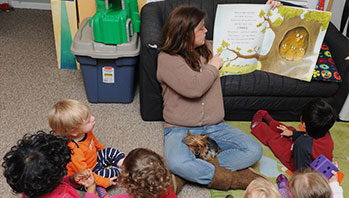- sentence chart
- sentence strips, each with one of these sentences: “We will go to pick turnips,” “We will go to pick apples,” “We will go to the fair”
- storyboard and figures for The Three Little Pigs
MA Standards:
English Language Arts/Foundational Skills/RF.PK.MA.1 With guidance and support, demonstrate understanding of the organization and basic features of printed and written text: books, words, letters, and the alphabet.
English Language Arts/Literature/RL.PK.MA.1 With prompting and support, ask and answer questions about a story or a poem read aloud.
English Language Arts/Reading for Informational Text/RI.P.MA.7 With prompting and support, describe important details from an illustration or photograph.
Head Start Outcomes:
Literacy Knowledge/Book Appreciation and Knowledge Asks and answers questions and makes comments about print materials.
Logic and Reasoning/Symbolic Representation Recognizes the difference between pretend or fantasy situations and reality.
PreK Learning Guidelines:
English Language Arts/Reading and Literature 6 Listen to a wide variety of age appropriate literature read aloud.
English Language Arts/Reading and Literature 10 Engage actively in read-aloud activities by asking questions, offering ideas, predicting or retelling important parts of a story or informational book.
Read Together: The Three Little Pigs #3

© Commonwealth of Massachusetts, Department of Early Education and Care (Jennifer Waddell photographer). All rights reserved.
ELA Focus Skills: Compare and Contrast, Listening and Speaking, Sequencing, Story Comprehension, Story Elements (Character), Vocabulary (use words related to time)
Tell children you are going to reread The Three Little Pigs. Set a reading focus for children by having them notice when events happen in the story.
Before You Read
Show children the cover and have them locate the title and read it aloud with you. Ask children to recall how this version of The Three Little Pigs is like other versions they have heard or seen. How is it different from other versions?
As You Read
- Use different voices and gestures to emphasize characterization for children.
- Have everyone chime in with the repetitive lines.
After You Read
Return to the pages that show the sequence of events with the wolf and the third little pig.
- Place the sentence strips in the sentence chart, out of order. Read them aloud. Ask, Is that the way things happened in the story?
- Have children tell in which order the events happened. Put the strips in the correct order and have children help you read them aloud.
Invite children to retell the whole story. Encourage them to act out the characters as they retell an event. If possible, videotape so children can watch their performances in the Technology Center.
English Language Learners: Point to the illustrations in the book. Invite English language learners to make any connections to the pictures and to their own life. For example, point to an illustration such as the page that says, Please, man give me those bricks to build me a house. Make a connection by asking children, What material is your house made out of? Or take children outside and ask what material the school is made of.
Adaptation: Groups with a varied age range may wish to pair older and younger children so that older children can “guide” younger ones in how to make up dialogue.
